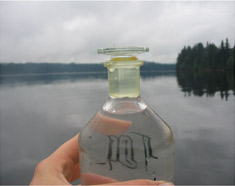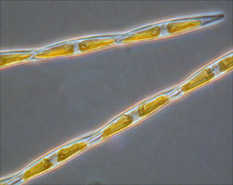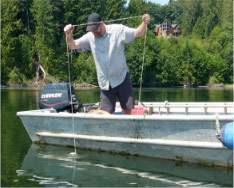PSI efforts to protect shellfish include wide-ranging research and outreach on the affects of ocean acidification, pollutants, contaminants and excess nutrients, diseases of shellfish, and harmful algal blooms. We also conduct in-depth research on methods to reduce the risk of human illnesses associated with the consumption of shellfish.
CHANGING OCEAN CONDITIONS
Ocean Acidification
PSI is dedicated to enhancing resiliency of shellfish and the shellfish industry to disease and changing ocean conditions. In the Pacific Northwest and Puget Sound, the combination of upwelled low-pH waters, low alkalinity and increased anthropogenic CO2 create some of the most corrosive conditions in the world's ocean surface. Organisms that produce a calcium carbonate shell, like shellfish, are considered particularly vulnerable to ocean acidification because such conditions lead to a reduction in the carbonate ion needed for calcification.
In recent years, declining Pacific oyster populations in Willapa Bay, WA were correlated with changes in water conditions that have been attributed to ocean acidification. Since 2007, several West Coast oyster hatcheries have also reported unusually high mortalities of early-stage Pacific oyster larvae, generally associated with upwelled, corrosive deep water. Production of shellfish seed for commercial as well as restoration is almost completely dependent upon hatchery production. Ocean acidification could severely impact commercial and restoration efforts by reducing the viability of larvae, setting success, and growth and survival. It is, therefore, critically important that resource managers, local industries, restoration programs, and the general public understand the extent to which ocean acidification will affect the survival of shellfish populations along the West Coast.
PSI and partners throughout the region are working to understand the extent and impact of ocean acidification on bivalve shellfish. PSI researchers are currently helping to inform shellfish growers and researchers of pertinent water quality variables near shellfish setting, remote setting and hatchery sites, these include monitoring stations in Washington's Willapa Bay and at the Lummi Lagoon in North Puget Sound. These stations record dissolved oxygen (DO), pH, salinity, oxidation reduction potential (ORP) temperature, and in some areas, CO2. Near real-time data is available at Willapa's Nahcotta and Bay Center sites and can be accessed through the NANOOS (the Pacific Northwest regional ocean observing system) portal (www.nanoos.org/nvs). Weekly water samples are also taken at all sites to identify levels of nutrients and vibrio bacteria in the water and to determine carbon chemistry variables including pCO2, TCO2 and saturation state. Saturation state is the best variable used to determine the suitability of water for early oyster shell formation.
MARINE POLLUTANTS AND CONTAMINANTS
Harmful Algal Blooms (HABs)
PSI participates in the SoundToxins rapid-response program by assisting with volunteer on-site training and support, data quality assurance, and harmful algal bloom (HAB) monitoring. The SoundToxins (www.soundtoxins.org) monitoring program is a partnership among shellfish growers, learning centers, tribes, and volunteers designed to provide early warning of harmful algal blooms (HABs) in order to minimize both human health risks and economic losses to Puget Sound fisheries. PSI participates in monitoring programs such as SoundToxins and the Olympic Region Harmful Algal Bloom partnership (ORHAB) because of the valuable role these programs play in better understanding and predicting HAB events.
Animal Waste
PSI also conducts outreach and education related to reducing bacterial contamination within Puget Sound. Activities have included initiating a pet waste education campaign, printing and distributing brochures (Pet Waste: What's the Problem?), installing banners, running Intercity Transit bus signs, performing outreach at community events using our dog mascot, Scoopy Doo, and providing hands-on presentations to community and/or school groups. PSI is also currently evaluating the feasibility of installing a methane digester for dog waste at a South Puget Sound park. PSI outreach efforts also include oil spill preparedness training for shellfish growers. Hazardous Waste Operations and Emergency Response Standard (HAZWOPER) training is an OSHA requirement for anyone who wants to be on the ground during oil spill control/containment operations. This includes anyone seeking access to lands (private or public) that have been oiled and not yet cleaned.
Metals
The presence of metals as a contaminant in shellfish is largely an issue restricted to pollutants from industrial or urban runoff, where shellfish harvests are prohibited or restricted. However, recent changes in standards (primarily from certain importing countries) regarding measured levels of cadmium have elevated concerns over the naturally occurring presence of this and other metals.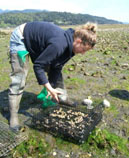 With limited data, Pacific oyster farmers were uncertain as to the extent of the problem in both geographic and economic terms. Methods, if any, to minimize cadmium residues in oysters were also unknown. In response, work was completed to determine the spatial distribution of cadmium in Pacific oysters harvested from growing areas located throughout Puget Sound and several other west coast estuaries. Based on these results, specific locations were selected for seasonal sampling of oyster tissue, seawater, sediments and shellfish growth rates to better understand the mechanisms behind the geographic distribution. Laboratory up- take and depuration experiments, as well as field experiments designed to minimize cadmium residues in shellfish, were also performed. Finally, an economic assessment was completed to evaluate potential losses associated with this issue. The Oregon State University Seafood Laboratory was the lead on this project, and we were joined by Integral Consulting, Inc., Northern Economics, Inc. and Hong Kong University of Sciences and Technology. With limited data, Pacific oyster farmers were uncertain as to the extent of the problem in both geographic and economic terms. Methods, if any, to minimize cadmium residues in oysters were also unknown. In response, work was completed to determine the spatial distribution of cadmium in Pacific oysters harvested from growing areas located throughout Puget Sound and several other west coast estuaries. Based on these results, specific locations were selected for seasonal sampling of oyster tissue, seawater, sediments and shellfish growth rates to better understand the mechanisms behind the geographic distribution. Laboratory up- take and depuration experiments, as well as field experiments designed to minimize cadmium residues in shellfish, were also performed. Finally, an economic assessment was completed to evaluate potential losses associated with this issue. The Oregon State University Seafood Laboratory was the lead on this project, and we were joined by Integral Consulting, Inc., Northern Economics, Inc. and Hong Kong University of Sciences and Technology.
ILLNESSES ASSOCIATED WITH EATING SHELLFISH
Evaluating practical methods for reducing Vibrios in shellfish
Vibriosis is a disease caused by an infection with bacteria of the Vibrio genus, most commonly Vibrio parahemolyticus (Vp) or Vibrio vulnificus (Vv). Vibrio bacteria cause diarrhea, skin infections, and/or blood infections. The diarrhea-causing Vp is a relatively harmless infection, but Vv infection, though rare, can lead to blood poisoning and death. Vp occurs naturally in marine coastal waters of the Pacific Northwest and Alaska, and is more common in the warmer summer months. Vv is fortunately, absent or extremely rare in U.S. west coast waters.
PSI has been conducting manipulative experiments and analyses of factors influencing Vibrio levels and post-harvest methods to minimize the risk of Vibrio contamination in oysters, the most common species implicated in shellfish-related food poisoning. This work has focused on: 1) alternative post-harvest treatment measures; and 2) enhanced control of pathogenic Vp in shellfish on shellfish farms.
Research on alternative post-harvest treatment measures is described in a summary for the project: "The Relationships Between Water Temperature, Immersion Time and Exposure to Bactericidal Oxidation Products on Pathogenic Vibrios In Gulf Oysters (National Gulf Oyster Industry)"
The second study evaluates the success of various post-harvest holding methods (temperature controlled-seawater depuration systems or ambient seawater at the harvest site) in reducing the levels of Vp in oysters. When Vp-caused human illness occurs due to raw shellfish consumption, and is reported, the shellfish industry experiences a reduction in oyster sales, as well as a consequently significant financial hardship and loss of revenue to largely rural agricultural communities. This project is intended to improve methods for control of Vp levels at the farm or harvest sites, before an illness outbreak is threatened or occurs. Work to date, and companion studies by the Washington State Department of Health, suggest modest reductions in Vp may be possible by moving oysters containing elevated Vp levels following harvest to ambient flowing seawater in tanks or open water holding (see figures).
Unfortunately, Vp levels between individual oysters appear to be extremely variable and high counts may be masked in composite samples. Also, holding tank or open water depuration will not be allowed if an illness has been reported in product originating from the farm site. Relaying, prior to a Vp illness related closure, may be possible and this option remains to be investigated.
SHELLFISH DISEASE
PSI's first ten years were highlighted by a suite of major investigations of shellfish diseases. Supported by a team of internationally recognized shellfish disease specialists, geneticists, and physiologists, our projects have focused on critical issues affecting the survival and growth or farmed and wild-harvested bivalve shellfish, including oyster herpes virus, summer mortality.
Pacific oyster summer mortalities are a recurring problem in the U.S., Japan, France, and Mexico. This disease condition affects seed to market sized animals and causes significant economic hardship for oyster culturists. Recent PSI research assessed the relationships among genetic, environmental and reproductive/pathogen processes associated with summer mortality events and found significant variations in mortality between pair-mated lines of oysters; and that selective breeding for increased resistance to summer mortality could lead to further development of high-performing oyster families. This research fulfilled our primary objectives to create selected pedigreed populations allowing the founding of commercial summer mortality-resistant stocks and beyond and opening avenues of future research quantitative-trait loci (QTL mapping, functional genomics, proteomics) to test hypotheses about the ultimate genetic and physiological causes of this complex trait.
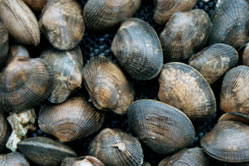 PSI has also worked on cooperative studies into clam survival and performance and risk assessments in regard to the biological hazard identified as Mikrocytos mackini, causative agent of Denman Island disease of Pacific oysters (Crassostrea gigas) and other oyster species. In addition, PSI developed guidelines to facilitate the process of obtaining import certification for live shellfish products from governments of importing countries or states and to reduce the risk of spreading infectious shellfish diseases. Such certification ensures that producers have access to markets in countries or trading blocks that have established trade agreements with the United States. PSI has also worked on cooperative studies into clam survival and performance and risk assessments in regard to the biological hazard identified as Mikrocytos mackini, causative agent of Denman Island disease of Pacific oysters (Crassostrea gigas) and other oyster species. In addition, PSI developed guidelines to facilitate the process of obtaining import certification for live shellfish products from governments of importing countries or states and to reduce the risk of spreading infectious shellfish diseases. Such certification ensures that producers have access to markets in countries or trading blocks that have established trade agreements with the United States.
|
|
|






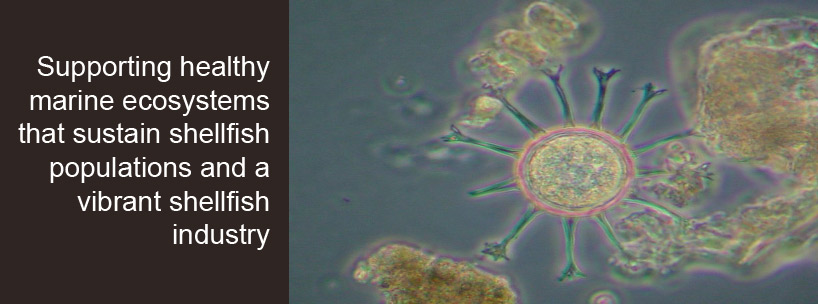

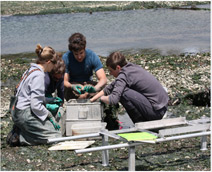
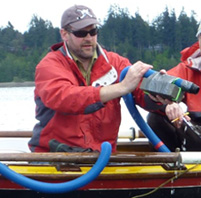
 With limited data, Pacific oyster farmers were uncertain as to the extent of the problem in both geographic and economic terms. Methods, if any, to minimize cadmium residues in oysters were also unknown. In response, work was completed to determine the spatial distribution of cadmium in Pacific oysters harvested from growing areas located throughout Puget Sound and several other west coast estuaries. Based on these results, specific locations were selected for seasonal sampling of oyster tissue, seawater, sediments and shellfish growth rates to better understand the mechanisms behind the geographic distribution. Laboratory up- take and depuration experiments, as well as field experiments designed to minimize cadmium residues in shellfish, were also performed. Finally, an economic assessment was completed to evaluate potential losses associated with this issue. The Oregon State University Seafood Laboratory was the lead on this project, and we were joined by Integral Consulting, Inc., Northern Economics, Inc. and Hong Kong University of Sciences and Technology.
With limited data, Pacific oyster farmers were uncertain as to the extent of the problem in both geographic and economic terms. Methods, if any, to minimize cadmium residues in oysters were also unknown. In response, work was completed to determine the spatial distribution of cadmium in Pacific oysters harvested from growing areas located throughout Puget Sound and several other west coast estuaries. Based on these results, specific locations were selected for seasonal sampling of oyster tissue, seawater, sediments and shellfish growth rates to better understand the mechanisms behind the geographic distribution. Laboratory up- take and depuration experiments, as well as field experiments designed to minimize cadmium residues in shellfish, were also performed. Finally, an economic assessment was completed to evaluate potential losses associated with this issue. The Oregon State University Seafood Laboratory was the lead on this project, and we were joined by Integral Consulting, Inc., Northern Economics, Inc. and Hong Kong University of Sciences and Technology. PSI has also worked on cooperative studies into clam survival and performance and risk assessments in regard to the biological hazard identified as Mikrocytos mackini, causative agent of Denman Island disease of Pacific oysters (Crassostrea gigas) and other oyster species. In addition, PSI developed guidelines to facilitate the process of obtaining import certification for live shellfish products from governments of importing countries or states and to reduce the risk of spreading infectious shellfish diseases. Such certification ensures that producers have access to markets in countries or trading blocks that have established trade agreements with the United States.
PSI has also worked on cooperative studies into clam survival and performance and risk assessments in regard to the biological hazard identified as Mikrocytos mackini, causative agent of Denman Island disease of Pacific oysters (Crassostrea gigas) and other oyster species. In addition, PSI developed guidelines to facilitate the process of obtaining import certification for live shellfish products from governments of importing countries or states and to reduce the risk of spreading infectious shellfish diseases. Such certification ensures that producers have access to markets in countries or trading blocks that have established trade agreements with the United States.